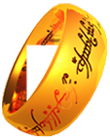Things of Middle-earth
Adûnaic
Type: Languages & Writing Systems
Meaning: Language of the West
Other Names: Númenorean
Description:[Adûnaic seems to have been a hybrid between whatever original language Men created for themselves upon awaking at Hildórien, mixed with Avari, Sindarin and Khuzdul. It was the vernacular tongue of Númenor, and underwent further evolution during the Second Age, but after the Downfall fell into disuse among the survivors, as the Faithful used Sindarin (and Quenya as a "scholarly language") and adopted the Common Speech or Westron that had evolved from Adûnaic in the North-west of Middle-earth.]
[The] native speech of the Númenoreans remained for the most part their ancestral Mannish tongue, the Adûnaic, and to this in the latter days of their pride their kings and lords returned, abandoning the Elven-speech, save only those few that still held to their ancient friendship with the Eldar. In the years of their power the Númenoreans had maintained many forts and havens upon the western coasts of Middle-earth for the help of their ships; and one of the chief of these was at Pelargir near the Mouths of Anduin. There Adûnaic was spoken, and mingled with many words of the languages of lesser men it became a Common Speech that spread thence along the coasts among all that had dealings with Westernesse.
After the downfall of Númenor, Elendil led the survivors of the Elf-friends back to the North-western shores of Middle-earth. There many already dwelt who were in whole or part of Númenorean blood; but few of them remembered the Elvish speech. All told the Dúnedain were thus from the beginning far fewer in number that the lesser men among whom they dwelt and whom they ruled, being lords of long life and great power and wisdom. They used therefore the Common Speech in their dealings with other folk and in the government of their wide realms; but they enlarged the language and enriched it with many words drawn from the Elven-tongues.
The Return of the King, LoTR Appendix F, The Languages and Peoples of the Third Age: Of Men
Structurally and grammatically [Khuzdul] differed widely from all other languages of the West at that time; though it had some features in common with Adûnaic, the ancient 'native' language of Númenor. This gave rise to the theory (a probable one) that in the unrecorded past some of the languages of Men — including the language of the dominant element in the Atani from which Adûnaic was derived — had been influenced by Khuzdul.
The Peoples of Middle-Earth, HoME Vol 12, Part 2, Ch 10, Of Dwarves and Men: Notes, Note 4
The ancient Adûnaic of Númenor became worn down by time - and by neglect. For owing to the disastrous history of Númenor it was no longer held in honour by the 'Faithful' who controlled all the Shorelands from Lune to Pelargir. For the Elvish tongues were proscribed by the rebel Kings, and Adûnaic alone was permitted to be used, and many of the ancient books in Quenya or in Sindarin were destroyed. The Faithful, therefore, used Sindarin, and in that tongue devised all names of places that they gave anew in Middle-earth. Adûnaic was abandoned to unheeded change and corruption as the language of daily life, and the only tongue of the unlettered. All men of high lineage and all those who were taught to read and write used Sindarin, even as a daily tongue among themselves. In some families, it is said, Sindarin became the native tongue, and the vulgar tongue of Adûnaic origin was only learned casually as it was needed.
The Peoples of Middle-Earth, HoME Vol 12, Part 2, Ch 10, Of Dwarves and Men: The Atani and their Languages
Contributors: Zimraphel. 7/6/2003; Tanaqui: added quotation 11.20.04, information from HoMe 11.22.04
